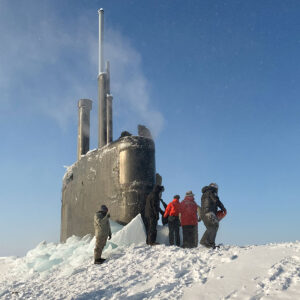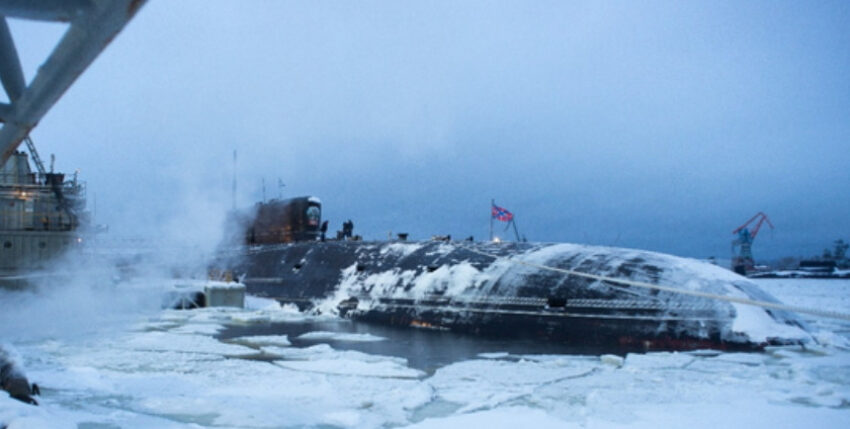Whether in the North Pacific or at the North Pole, the rivalry between the major powers and political and ecological climate change influence each other.
Imagine a scene in the years to come: The history of the self-proclaimed "People's Republics" of Donetsk and Luhansk in Ukraine would end in mishap. Before the separatist strongholds would finally become the property of the Ukrainian state, the flag of the Russian protecting power was to be ceremoniously lowered one last time. But instead of slowly gliding down, the white, blue and red tricolour would get caught on the mast. Several sailors would have to climb up to release the cloth. In the process, the symbol of imperial power would fall so awkwardly that it would get caught in the bayonets of the lined-up soldiers and tear in several places. After this embarrassing incident, the only thing left to do was to end the matter as quickly as possible. The representatives of Russia and Ukraine would exchange a few - to the chagrin of the media present - barely intelligible words, shake hands and thus finally seal the transfer of the "People's Republics" from one state to the other. The Ukrainian flag would then be raised.
How currently unimaginable and yet at the same time very fitting to recent Russian-Ukrainian history such a scene would be. Especially as it has already happened - just not in the 21st century, but two centuries earlier. And not in Ukraine either, but in what is now Alaska, in what was then Russian America. Even back then, Moscow and Washington were at odds with each other - not in Europe, but in America.
It is therefore all the more commendable that Robert Kindler has written about this scene and its history in his book "Robbenreich. Russia and the Limits of Power in the North Pacific". Reading it causes many a déjà vu in view of the current news situation and its possible consequences. The Eastern European historian, who researches and teaches at Humboldt-Universität zu Berlin and Freie Universität Berlin, wrote an award-winning book, "Stalin's Nomads - Rule and Hunger in Kazakhstan", in the year that Russia occupied Crimea, an almost unknown chapter of Russian history in the West - not only was Ukraine subjected to a famine by Stalin with millions of victims, but also the multi-ethnic population of Kazakhstan as a result of their subjugation through sedentarisation, collectivisation and dekulakisation.
Kindler called Stalin's brutal methodology "Sovietisation through hunger" - here too a cause for déjà vu with regard to Putin's hunger weapon, created by his invasion of Ukraine, used against the coalition of international sanctions in response to Russia's aggression.
Kindler now turns his attention to another chapter of Russian history that is little known in Europe. In view of current developments, this too seems like a prehistory of the present. Kindler's depiction of Russia's involvement in the North Pacific in the 19th century also reflects a history of ongoing conflicts over influence, power and resources. The setting is the North Pacific "seal kingdom" of fur seals, whose pelts were extremely sought-after on the global smoked goods market at the end of the 19th century, according to Kindler's observations. The economic struggle for these seals in the imperial periphery of the Russian Tsarist Empire with state and private players from the United States, Canada and Japan was correspondingly fierce. In Kindler's eyes, the Russian state's model of rule, which was already based on expansion, exploitation and subjugation, reached its limits: finally, Tsar Alexander II sold Russian America to the USA in 1867. Today's Alaska was created. The Russian flag was taken down and the American flag was raised.
Flags are also the subject of Michael Paul's book "The Battle for the North Pole. The Arctic, climate change and the rivalry of the superpowers". Flags have stood and continue to stand for the claims of great powers not only in the North Pacific, but also at the North Pole. At the same time, these northernmost theatres of traditional power politics have always been and still are in the slipstream of public attention - which is currently captivated by the new hot Cold War between Russia and the West in Ukraine and the new great game between China and the United States for supremacy in Asia and thus also for global supremacy.
Who looks to the North Pole? Those like Paul, who have noticed how the two strong influences of the present - climate change and the renewed warlike rivalry between the great powers - form two poles that influence each other, especially in the Arctic. The Senior Fellow at the German Institute for International and Security Affairs in Berlin describes climate change not only as a key driver of change in the Arctic, but also as responsible for the "Arctic paradox": warming and the ever-increasing melting of ice on land and at sea would make it possible to better utilise sea routes and resources, which in turn would have an impact on the climate.

According to Paul's analysis, this has led to a security dilemma in the region: Due to climate change, the Arctic has become the venue for competition between major powers. In addition, there are Russian military activities that unsettle European NATO states in the north and increase the presence of American armed forces, which in turn strengthens Russia's threat perception.
Paul favourably points out that the Arctic has only been a security policy issue again for a few years. Nevertheless, strategic and military considerations have never completely disappeared since the end of the old Cold War. In Paul's eyes, the Arctic remains of great importance for Russia and the USA, which are only 85 kilometres apart in the Bering Strait, simply because of its location. And in view of the renewed nuclear threats from Moscow, at the latest since the start of the Russian war of aggression against Ukraine, Paul reminds us that in the event of a nuclear exchange today, Russian and American intercontinental missiles would also take their course over the Arctic Ocean.
What the Arctic has in common with the main theatres of the new Cold War in Europe and Asia is that there was also hope for a lasting era of cooperation between East and West in the 1990s. According to Paul, the 21st century could even have been the "era of the Arctic". But instead, since the early 2020s at the latest, the rivalry between major powers has returned - both militarily and economically.
However, only a small part of the recent political conflicts and tensions originate from the Arctic itself. According to Paul's observations, most of them come from outside - as geopolitical collateral damage, so to speak, from the competition between China, Russia and the USA. This is because the Arctic is important for various reasons in order to maintain or increase its own status: Washington has identified it as an "arena" in the struggle for power and influence and wants to maintain the status quo. Moscow wants to use it as a resource base to expand its role as a great power. And Beijing wants to instrumentalise it for its rise as a world power. Paul describes the respective handling of the shipping routes as typical of this: The Americans want free routes, the Russians want to limit access. In the Arctic at least, Russia's spectacular action in 2007, in which a Russian flag was placed on the seabed at the North Pole at a depth of over four thousand metres, remains unforgotten - along with Moscow's declaration that the Arctic is Russian. Will this flag also be ceremoniously lowered one day?
This article follows on from an article published in the Neue Zürcher Zeitung on 7 June 2022.
Thomas Speckmann is a historian and political scientist and has lectured at the universities of Bonn, Münster, Potsdam and the FU Berlin.
Thomas Speckmann










